Related Research Articles

A forest is an ecosystem characterized by a dense community of trees. Hundreds of definitions of forest are used throughout the world, incorporating factors such as tree density, tree height, land use, legal standing, and ecological function. The United Nations' Food and Agriculture Organization (FAO) defines a forest as, "Land spanning more than 0.5 hectares with trees higher than 5 meters and a canopy cover of more than 10 percent, or trees able to reach these thresholds in situ. It does not include land that is predominantly under agricultural or urban use." Using this definition, Global Forest Resources Assessment 2020 found that forests covered 4.06 billion hectares, or approximately 31 percent of the world's land area in 2020.

Eucalyptus is a genus of more than 700 species of flowering plants in the family Myrtaceae. Most species of Eucalyptus are trees, often mallees, and a few are shrubs. Along with several other genera in the tribe Eucalypteae, including Corymbia and Angophora, they are commonly known as eucalypts or "gum trees". Plants in the genus Eucalyptus have bark that is either smooth, fibrous, hard, or stringy, the leaves have oil glands, and the sepals and petals are fused to form a "cap" or operculum over the stamens. The fruit is a woody capsule commonly referred to as a "gumnut".
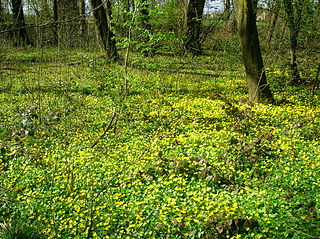
In forestry and ecology, understory, or understorey, also known as underbrush or undergrowth, includes plant life growing beneath the forest canopy without penetrating it to any great extent, but above the forest floor. Only a small percentage of light penetrates the canopy so understory vegetation is generally shade-tolerant. The understory typically consists of trees stunted through lack of light, other small trees with low light requirements, saplings, shrubs, vines and undergrowth. Small trees such as holly and dogwood are understory specialists.

An old-growth forest is a forest that has developed over a long period of time without disturbance. Due to this, old-growth forests exhibit unique ecological features. The Food and Agriculture Organization of the United Nations defines primary forests as naturally regenerated forests of native tree species where there are no clearly visible indications of human activity and the ecological processes are not significantly disturbed. One-third of the world's forests are primary forests. Old-growth features include diverse tree-related structures that provide diverse wildlife habitats that increases the biodiversity of the forested ecosystem. Virgin or first-growth forests are old-growth forests that have never been logged. The concept of diverse tree structure includes multi-layered canopies and canopy gaps, greatly varying tree heights and diameters, and diverse tree species and classes and sizes of woody debris.

Eucalyptus gomphocephala, known as tuart, is a species of tree and is one of the six forest giants of Southwest Australia.

Armillaria luteobubalina, commonly known as the Australian honey fungus, is a species of mushroom in the family Physalacriaceae. Widely distributed in southern Australia, the fungus is responsible for a disease known as Armillaria root rot, a primary cause of Eucalyptus tree death and forest dieback. It is the most pathogenic and widespread of the six Armillaria species found in Australia. The fungus has also been collected in Argentina and Chile. Fruit bodies have cream- to tan-coloured caps that grow up to 10 cm (4 in) in diameter and stems that measure up to 20 cm (8 in) long by 1.5 cm (1 in) thick. The fruit bodies, which appear at the base of infected trees and other woody plants in autumn (March–April), are edible, but require cooking to remove the bitter taste. The fungus is dispersed through spores produced on gills on the underside of the caps, and also by growing vegetatively through the root systems of host trees. The ability of the fungus to spread vegetatively is facilitated by an aerating system that allows it to efficiently diffuse oxygen through rhizomorphs—rootlike structures made of dense masses of hyphae.

The flora of Australia comprises a vast assemblage of plant species estimated to over 21,000 vascular and 14,000 non-vascular plants, 250,000 species of fungi and over 3,000 lichens. The flora has strong affinities with the flora of Gondwana, and below the family level has a highly endemic angiosperm flora whose diversity was shaped by the effects of continental drift and climate change since the Cretaceous. Prominent features of the Australian flora are adaptations to aridity and fire which include scleromorphy and serotiny. These adaptations are common in species from the large and well-known families Proteaceae (Banksia), Myrtaceae, and Fabaceae.

Eucalyptus salmonophloia, commonly known as salmon gum, wurak or weerluk or woonert or marrlinja. is a species of small to medium-sized tree that is endemic to Western Australia. It has smooth bark, narrow lance-shaped to curved adult leaves, flower buds in groups of between nine and thirteen, creamy white flowers and hemispherical fruit.

Mount Banda Banda, a mountain of the Mid North Coast region of New South Wales, Australia, is situated 320 kilometres (200 mi) from Sydney within the Willi Willi National Park. Banda Banda can be seen on the north-western horizon from Port Macquarie, as well as on the south-western horizon 39 km from the town of Kempsey. At 1,258 metres (4,127 ft) AHD it is the highest mountain in the region.
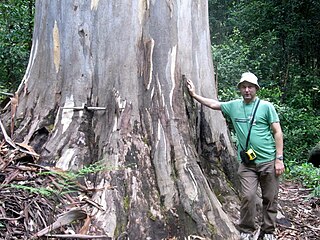
The Currency Creek Arboretum is located in the Australian state of South Australia near the small town of Currency Creek and south of the state capital of Adelaide. CCA is a 32-hectare (79-acre) specialist Eucalypt arboretum and research centre, composed solely of Australian native plants.

The Kimberley tropical savanna is a tropical and subtropical grasslands, savannas, and shrublands ecoregion in northwestern Australia, covering portions of Western Australia and the Northern Territory south of the Timor Sea.

Dry sclerophyll forests occur throughout northern and eastern Tasmania. Characterised by the population of hard-leafed (sclerophyll) and often spiky, drought-adapted plants, dry sclerophyll forests are found in regions of where annual rainfall is below 1000mm.

Monvert Nature Park is a nature walk, arboretum, botanical gardens and rehabilitated indigenous forest, situated in Forest Side, Curepipe, Mauritius.
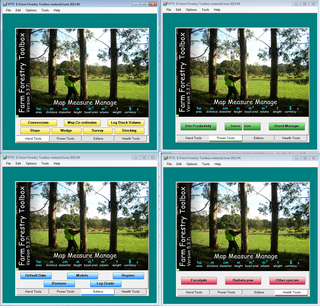
The Farm Forestry Toolbox is a collection of computer programs, referred to as 'Tools', intended to be used by farm forest owners and managers to aid decision making. The Toolbox includes a set of simple 'Hand Tools'; conversion of measurements and map co-ordinates; measuring the volume of stacked logs, slope, basal area; and a survey tool. A second set of more complex tools or 'Power Tools'; can be used to estimate site productivity, volume and value of wood grown for individual trees, at the coupe or stand level and forest estate level.

Eucalyptus socialis, commonly known as the red mallee, or grey mallee, is a species of mallee that is endemic to inland Australia.

Eucalyptus argophloia, commonly known as Queensland western white gum, Queensland white gum, scrub gum, lapunyah, Burncluith gum or Chinchilla white gum is a tree that is endemic to a small area of Queensland. It has smooth white bark ageing to other colours, narrow lance-shaped adult leaves, more or less spherical flower buds in groups of seven, white flowers and small, hemispherical to cup-shaped fruit.
Clifford David Boomsma was an Australian forester, botanist and botanical collector.
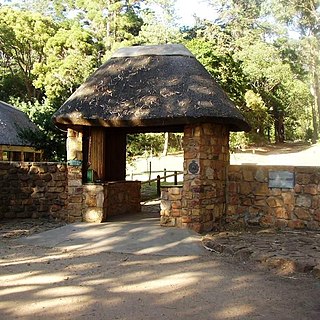
The Tokai Arboretum was the first large-scale silviculture experimental station in Cape Town, South Africa. The area of the main Arboretum, at Tokai Park, is 14 ha. Several adjacent compartments extend the area to 26 ha. The Arboretum was declared a National Monument in 1985, on its 100th anniversary. It contains stands of Eucalyptus and other trees from the original silviculture experiments in South Africa. In the 1990s a Gondwana Garden was created to display the plants typical of the Cape 100 million years ago.
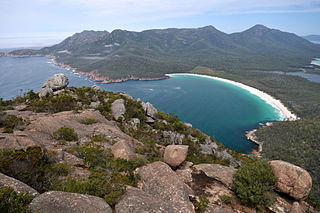
The Tasmanian temperate forests is a temperate broadleaf and mixed forests ecoregion in Australia. The ecoregion occupies the eastern portion of the island of Tasmania, which lies south of the Australian mainland.
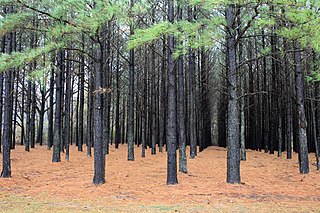
A tree plantation, forest plantation, plantation forest, timber plantation or tree farm is a forest planted for high volume production of wood, usually by planting one type of tree as a monoculture forest. The term tree farm also is used to refer to tree nurseries and Christmas tree farms.
References
- ↑ "Property Details". Tasman District Council . Retrieved 1 April 2024.
- ↑ Gaffney, Sally (2020). Man, slasher, wheelbarrow: The story of Milnthorpe Park Arboretum. Sally Gaffney. ISBN 9780473526290.
- ↑ "New Season Outlook 2023–24" (PDF). Beef + Lamb New Zealand. October 2023. Retrieved 1 April 2024.
- ↑ Maclaren, J. Piers (1996). Environmental Effects of Planted Forests in New Zealand. New Zealand Forest Research Institute.
- ↑ Maclaren, J. Piers (2000). Trees in the Greenhouse: Forest Research Bulletin No. 219. Rotorua: New Zealand Forest Research Institute.
- ↑ McGlone, Matt S.; Bellingham, Peter J.; Richardson, Sarah J. (2022). "Science, policy, and sustainable indigenous forestry in New Zealand". New Zealand Journal of Forestry Science. 52 (8). doi: 10.33494/nzjfs522022x182x .
- 1 2 Forbes, Adam S.; Norton, David A.; Carswell, Fiona E. (6 July 2019). "Opportunities and limitations of exotic Pinus radiata as a facilitative nurse for New Zealand indigenous forest restoration". New Zealand Journal of Forestry Science. 49 (6). doi: 10.33494/nzjfs492019x45x . ISSN 1179-5395.
- 1 2 Forbes, Adam S.; Wallace, Kiri J.; Buckley, Hannah L.; Case, Brad S.; Clarkson, Bruce D.; Norton, David A. (2020). "Restoring mature-phase forest tree species through enrichment planting in New Zealand's lowland landscapes". New Zealand Journal of Ecology . 44 (1). doi: 10.20417/nzjecol.44.10 .
- ↑ Te Uru Rākau; Forbes, Adam S. (August 2021). Transitioning Exotic Plantations to Native Forest: A Report on the State of Knowledge (Report). Ministry for Primary Industries.